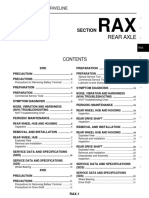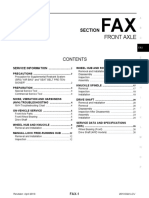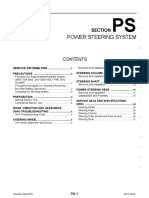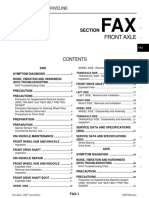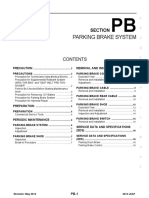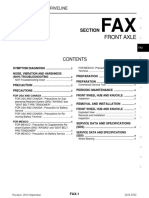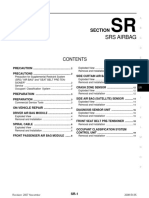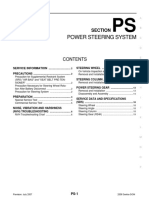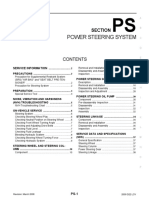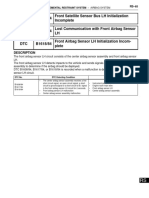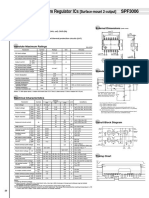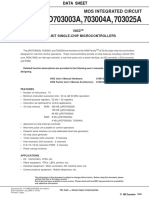Rear Axle: Section
Rear Axle: Section
Uploaded by
MaiChiVuCopyright:
Available Formats
Rear Axle: Section
Rear Axle: Section
Uploaded by
MaiChiVuOriginal Description:
Original Title
Copyright
Available Formats
Share this document
Did you find this document useful?
Is this content inappropriate?
Copyright:
Available Formats
Rear Axle: Section
Rear Axle: Section
Uploaded by
MaiChiVuCopyright:
Available Formats
TRANSMISSION & DRIVELINE
SECTION RAX REAR AXLE
B
RAX
E
CONTENTS
PRECAUTION ............................................... 2 On-Vehicle Inspection and Service .......................... 6 F
PRECAUTIONS ................................................... 2 REMOVAL AND INSTALLATION ................ 7
Precaution for Supplemental Restraint System G
(SRS) "AIR BAG" and "SEAT BELT PRE-TEN- WHEEL HUB ...................................................... 7
SIONER" ................................................................... 2 Removal and Installation .......................................... 7
Precaution Necessary for Steering Wheel Rota- REAR DRIVE SHAFT ......................................... 9 H
tion After Battery Disconnect ..................................... 2
Component ............................................................... 9
Caution ...................................................................... 3
Removal and Installation .......................................... 9
PREPARATION ............................................ 4 DISASSEMBLY AND ASSEMBLY .............. 11 I
PREPARATION ................................................... 4 REAR DRIVE SHAFT ........................................ 11
Special Service Tool ................................................. 4
Disassembly and Assembly .....................................11 J
Commercial Service Tool .......................................... 4
SERVICE DATA AND SPECIFICATIONS
SYMPTOM DIAGNOSIS ............................... 5
(SDS) ............................................................ 16
K
NOISE, VIBRATION AND HARSHNESS
SERVICE DATA AND SPECIFICATIONS
(NVH) TROUBLESHOOTING ............................. 5
NVH Troubleshooting Chart ...................................... 5
(SDS) ................................................................. 16
Wheel Bearing .........................................................16 L
ON-VEHICLE MAINTENANCE ..................... 6 Drive Shaft ...............................................................16
Boot Bands ..............................................................16
WHEEL HUB ....................................................... 6 M
Revision: December 2009 RAX-1 2009 QX56
PRECAUTIONS
< PRECAUTION >
PRECAUTION
PRECAUTIONS
Precaution for Supplemental Restraint System (SRS) "AIR BAG" and "SEAT BELT
PRE-TENSIONER" INFOID:0000000005873184
The Supplemental Restraint System such as “AIR BAG” and “SEAT BELT PRE-TENSIONER”, used along
with a front seat belt, helps to reduce the risk or severity of injury to the driver and front passenger for certain
types of collision. This system includes seat belt switch inputs and dual stage front air bag modules. The SRS
system uses the seat belt switches to determine the front air bag deployment, and may only deploy one front
air bag, depending on the severity of a collision and whether the front occupants are belted or unbelted.
Information necessary to service the system safely is included in the SR and SB section of this Service Man-
ual.
WARNING:
• To avoid rendering the SRS inoperative, which could increase the risk of personal injury or death in
the event of a collision which would result in air bag inflation, all maintenance must be performed by
an authorized NISSAN/INFINITI dealer.
• Improper maintenance, including incorrect removal and installation of the SRS, can lead to personal
injury caused by unintentional activation of the system. For removal of Spiral Cable and Air Bag
Module, see the SR section.
• Do not use electrical test equipment on any circuit related to the SRS unless instructed to in this
Service Manual. SRS wiring harnesses can be identified by yellow and/or orange harnesses or har-
ness connectors.
PRECAUTIONS WHEN USING POWER TOOLS (AIR OR ELECTRIC) AND HAMMERS
WARNING:
• When working near the Airbag Diagnosis Sensor Unit or other Airbag System sensors with the Igni-
tion ON or engine running, DO NOT use air or electric power tools or strike near the sensor(s) with a
hammer. Heavy vibration could activate the sensor(s) and deploy the air bag(s), possibly causing
serious injury.
• When using air or electric power tools or hammers, always switch the Ignition OFF, disconnect the
battery, and wait at least 3 minutes before performing any service.
Precaution Necessary for Steering Wheel Rotation After Battery Disconnect
INFOID:0000000005873185
NOTE:
• This Procedure is applied only to models with Intelligent Key system and NATS (NISSAN ANTI-THEFT SYS-
TEM).
• Remove and install all control units after disconnecting both battery cables with the ignition knob in the
″LOCK″ position.
• Always use CONSULT-III to perform self-diagnosis as a part of each function inspection after finishing work.
If DTC is detected, perform trouble diagnosis according to self-diagnostic results.
For models equipped with the Intelligent Key system and NATS, an electrically controlled steering lock mech-
anism is adopted on the key cylinder.
For this reason, if the battery is disconnected or if the battery is discharged, the steering wheel will lock and
steering wheel rotation will become impossible.
If steering wheel rotation is required when battery power is interrupted, follow the procedure below before
starting the repair operation.
OPERATION PROCEDURE
1. Connect both battery cables.
NOTE:
Supply power using jumper cables if battery is discharged.
2. Use the Intelligent Key or mechanical key to turn the ignition switch to the ″ACC″ position. At this time, the
steering lock will be released.
3. Disconnect both battery cables. The steering lock will remain released and the steering wheel can be
rotated.
4. Perform the necessary repair operation.
Revision: December 2009 RAX-2 2009 QX56
PRECAUTIONS
< PRECAUTION >
5. When the repair work is completed, return the ignition switch to the ″LOCK″ position before connecting
the battery cables. (At this time, the steering lock mechanism will engage.) A
6. Perform a self-diagnosis check of all control units using CONSULT-III.
Caution INFOID:0000000003772254
B
Observe the following precautions when disassembling and servicing drive shaft.
• Perform work in a location which is as dust-free as possible.
• Before disassembling and servicing, clean the outside of parts. C
• Prevention of the entry of foreign objects must be taken into account during disassembly of the service loca-
tion.
• Disassembled parts must be carefully reassembled in the correct order. If work is interrupted, a clean cover
RAX
must be placed over parts.
• Paper shop cloths must be used. Fabric shop cloths must not be used because of the danger of lint adhering
to parts.
• Disassembled parts (except for rubber parts) should be cleaned with kerosene which shall be removed by E
blowing with air or wiping with paper shop cloths.
Revision: December 2009 RAX-3 2009 QX56
PREPARATION
< PREPARATION >
PREPARATION
PREPARATION
Special Service Tool INFOID:0000000003772255
The actual shapes of the Kent-Moore tools may differ from those of the special service tools illustrated here.
Tool number Description
(Kent-Moore No.)
Tool name
KV38100500 Installing drive shaft plug
( — ) a: 80 mm (3.15 in) dia.
Drift b: 60 mm (2.36 in) dia.
ZZA0701D
KV38102200 Installing drive shaft plug
( — ) a: 90 mm (3.54 in) dia.
Drift b: 31 mm (1.22 in) dia.
ZZA0920D
KV40107300 Installing boot bands
( — )
Boot band crimping tool
ZZA1229D
Commercial Service Tool INFOID:0000000003772256
Tool name Description
Power tools Removing bolts and nuts
PBIC0190E
Revision: December 2009 RAX-4 2009 QX56
NOISE, VIBRATION AND HARSHNESS (NVH) TROUBLESHOOTING
< SYMPTOM DIAGNOSIS >
SYMPTOM DIAGNOSIS A
NOISE, VIBRATION AND HARSHNESS (NVH) TROUBLESHOOTING
NVH Troubleshooting Chart INFOID:0000000003772257
B
Use chart below to help you find the cause of the symptom. If necessary, repair or replace these parts.
C
DLN-242, "NVH Troubleshooting Chart"
DLN-194, "NVH Troubleshooting Chart"
FSU-5, "NVH Troubleshooting Chart"
RSU-5, "NVH Troubleshooting Chart"
WT-36, "NVH Troubleshooting Chart"
WT-36, "NVH Troubleshooting Chart"
FAX-5, "NVH Troubleshooting Chart"
ST-12, "NVH Troubleshooting Chart"
BR-6, "NVH Troubleshooting Chart"
RAX
RAX-9
RAX-9
RAX-7
—
—
Reference page
E
Improper installation, looseness
FRONT SUSPENSION
Joint sliding resistance
REAR SUSPENSION
PROPELLER SHAFT
Excessive joint angle
Parts interference
Possible cause and SUSPECTED PARTS
DIFFERENTIAL
ROAD WHEEL
FRONT AXLE
STEERING
I
Imbalance
BRAKES
TIRES
J
Noise × × × × × × × × × × × ×
Shake × × × × × × × × × × ×
Vibration × × × × × × × × × K
Symptom
Shimmy × × × × × × × ×
Shudder × × × × × × ×
L
Poor quality ride or handling × × × × × × × ×
×: Applicable
M
Revision: December 2009 RAX-5 2009 QX56
WHEEL HUB
< ON-VEHICLE MAINTENANCE >
ON-VEHICLE MAINTENANCE
WHEEL HUB
On-Vehicle Inspection and Service INFOID:0000000003772258
Inspect the components for any looseness or back lash. Inspect each component for any excessive wear or
damage. Replace any components as necessary.
WHEEL BEARING INSPECTION
• Move the wheel hub and bearing assembly in the axial direction by hand to check the axial end play. Check
that the axial end play is with specification. Replace the wheel hub and bearing assembly as necessary.
Axial end play : 0 mm (0 in)
• Rotate the wheel hub and bearing assembly to check that there are no unusual noises or other abnormal
conditions. Replace the wheel hub and bearing assembly as necessary.
Revision: December 2009 RAX-6 2009 QX56
WHEEL HUB
< REMOVAL AND INSTALLATION >
REMOVAL AND INSTALLATION A
WHEEL HUB
Removal and Installation INFOID:0000000003772260
B
Rear Wheel Hub and Bearing Assembly
C
RAX
WDIA0189E
H
1. Back plate 2. Rear ABS sensor 3. Wheel hub and bearing assembly
4. Wheel stud 5. Rear disc rotor 6. Cotter pin
I
NOTE:
The rear ABS sensor is routed through the back of the rear backing plate and into the side of the wheel hub
and bearing assembly. It is necessary to remove the wheel hub and bearing assembly to remove the rear ABS
sensor. J
REMOVAL
1. Remove the wheel and tire using power tool. K
2. Remove the rear brake caliper, without disconnecting the hydraulic hose, using power tool. Reposition the
rear brake caliper aside using suitable wire. Refer to BR-36, "Removal and Installation of Brake Caliper
and Disc Rotor". L
NOTE:
• Do not depress the brake pedal while the brake caliper is removed.
3. Remove the rear disc rotor.
M
4. Remove the cotter pin, then remove the nut from the drive shaft
using power tool.
• Discard the cotter pin, use a new one for installation.
N
5. Remove the drive shaft. Refer to RAX-9, "Removal and Installa-
tion".
P
LDIA0050E
6. Remove the four wheel hub and bearing assembly bolts using power tool.
• Discard the four wheel hub and bearing assembly bolts, use new ones for installation.
Revision: December 2009 RAX-7 2009 QX56
WHEEL HUB
< REMOVAL AND INSTALLATION >
7. Pull out the wheel hub and bearing assembly for access to
remove the rear ABS sensor from the wheel hub and bearing
assembly as shown.
• Inspect the ABS sensor O-ring, replace the ABS sensor
assembly if damaged.
• Clean the ABS sensor hole and mounting surface with a suit-
able brake cleaner and a clean lint-free shop rag. Be careful
that dirt and debris do not enter the axle bearing area.
• Apply a coat of suitable grease to the ABS sensor O-ring and
mounting hole.
CAUTION:
LDIA0052E
Do not pull on the ABS harness.
8. Remove the wheel hub and bearing assembly.
INSTALLATION
Installation is in the reverse order of removal.
• Apply grease 44003 7S000 to contact surface between wheel hub
and drive shaft. Use sufficient grease to completely coat contact
area.
• Inspect the ABS sensor O-ring, replace the ABS sensor assembly
if damaged.
• Clean the ABS sensor hole and mounting surface with a suitable
brake cleaner and a clean lint-free shop rag. Be careful that dirt
and debris do not enter the axle bearing area.
• Apply a coat of suitable grease to the ABS sensor O-ring and
mounting hole.
• Use a new cotter pin for installation.
WDIA0291E
• Use new wheel hub and bearing assembly bolts for installation.
Revision: December 2009 RAX-8 2009 QX56
REAR DRIVE SHAFT
< REMOVAL AND INSTALLATION >
REAR DRIVE SHAFT
A
Component INFOID:0000000003772259
Rear Drive Shaft B
RAX
WDIA0263E
1. Rear final drive assembly 2. Rear drive shaft 3. Rear brake and hub assembly K
4. Cotter pin
Removal and Installation INFOID:0000000005889856 L
REMOVAL
1. Remove the wheel and tire using power tool. M
2. Remove the stabilizer bar clamp. Refer to RSU-23, "Removal and Installation".
3. Remove the cotter pin and discard, then remove the drive shaft
nut from the drive shaft. N
• Do not reuse the cotter pin, discard after removal and use a
new cotter pin for installation.
O
LDIA0050E
4. Remove the six bolts from the inside flange of the drive shaft using power tool.
• Do not reuse the drive shaft inside flange bolts, discard after removal and use new bolts for installation.
Revision: December 2009 RAX-9 2009 QX56
REAR DRIVE SHAFT
< REMOVAL AND INSTALLATION >
5. Separate the drive shaft from the wheel hub and bearing assembly by lightly tapping the end with a suit-
able hammer and wood block. If it is difficult to separate, use a suitable puller.
6. Remove the drive shaft.
CAUTION:
When removing the drive shaft, do not bend at an excessive angle to the drive shaft joint. Do not
excessively extend the slide joint.
INSPECTION AFTER REMOVAL
• Move the joint up and down, left and right, and in the axial direc-
tion. Check for any rough movement or significant looseness.
• Check the boot for cracks or other damage, and for any grease
leakage.
• If necessary, disassemble the drive shaft, and repair as necessary.
RAA0030D
INSTALLATION
Installation is in the reverse order of removal.
• Do not reuse the drive shaft inside flange bolts, discard after removal and use new bolts for installation.
• Do not reuse the cotter pin, discard after removal and use a new cotter pin for installation.
Drive shaft lock nut : Refer to RAX-9, "Component".
Drive shaft inside flange bolts : Refer to RAX-9, "Component".
Revision: December 2009 RAX-10 2009 QX56
REAR DRIVE SHAFT
< DISASSEMBLY AND ASSEMBLY >
DISASSEMBLY AND ASSEMBLY A
REAR DRIVE SHAFT
Disassembly and Assembly INFOID:0000000005889855
B
RAX
SDIA1488E
H
1. Plug 2. Housing 3. Snap ring
4. Ball cage, steel ball, inner race assembly 5. Stopper ring 6. Boot band
7. Boot 8. Shaft 9. Circlip I
10. Joint sub-assembly
DISASSEMBLY J
Final Drive Side
1. Secure the drive shaft in a vise.
CAUTION: K
When securing the drive shaft in a vise, use copper or aluminum plates between the vise and the
drive shaft.
2. Remove the boot bands. L
3. If the plug needs to be removed, move the boot to the wheel side, then drive the plug out using a suitable
tool.
4. Remove the stopper ring using a suitable tool as shown, and pull M
the housing out.
SRA249A P
Revision: December 2009 RAX-11 2009 QX56
REAR DRIVE SHAFT
< DISASSEMBLY AND ASSEMBLY >
5. Remove the snap ring using a suitable tool, then remove the ball
cage, steel ball, inner race assembly from the drive shaft.
SFA514A
6. Remove the boot from the drive shaft.
7. Remove any old grease on the housing using paper towels.
Wheel Side
1. Secure the drive shaft in a vise.
CAUTION:
When securing the drive shaft in a vise, use copper or aluminum plates between the vise and the
drive shaft.
2. Remove the boot bands, then remove the boot from the joint sub-assembly.
3. Screw a suitable drive shaft puller 30 mm (1.18 in) or more into
the threaded part of the joint sub-assembly. Pull the joint sub-
assembly out of the drive shaft as shown.
CAUTION:
• If the joint sub-assembly cannot be removed after five or
more attempts, replace the drive shaft and joint sub-
assembly as a set.
• Align the sliding hammer and drive shaft and remove the
joint sub-assembly by pulling directly.
SDIA0606E
4. Remove the boot from the drive shaft.
5. Remove the circlip from the drive shaft.
6. While rotating the ball cage, remove any old grease on the joint sub-assembly using paper towels.
INSPECTION AFTER DISASSEMBLY
Drive Shaft
• Replace the drive shaft if there is any runout, cracking, or other damage.
Joint Sub-assembly
• Check for any rough rotation or unusual axial looseness.
• Clean any foreign material from inside the joint sub-assembly.
• Check for any compression scars, cracks, or fractures.
CAUTION:
If any defective conditions are found in the joint sub-assembly components, replace the entire joint
sub-assembly.
Sliding Joint Side (Housing)
• Check for any compression scars, cracks, fractures, or unusual wear on the ball rolling surface.
• Check for any damage to the drive shaft screws.
• Check for any deformation of the boot installation components.
Ball Cage
• Check the sliding surface for any compression scars, cracks, or fractures.
Steel Ball
• Check for any compression scars, cracks, fractures, or unusual wear.
Inner Race
Revision: December 2009 RAX-12 2009 QX56
REAR DRIVE SHAFT
< DISASSEMBLY AND ASSEMBLY >
• Check the ball sliding surface for any compression scars, cracks, or fractures.
• Check for any damage to the serrated part. A
CAUTION:
If any defective conditions are found, install a new housing, ball cage, steel ball, and inner race as a
set.
B
ASSEMBLY
Final Drive Side
C
1. If the plug has been removed, use Tool to press in a new one.
Tool number : KV38100500 ( — )
RAX
: KV38102200 ( — )
NOTE:
Discard the old plug and use a new one for assembly. E
F
SDIA1153E
2. Wrap the serrated part of the shaft with tape. Install the boot
band and boot to shaft. G
NOTE:
Discard the old boot band and boot and use a new one for
assembly. H
SFA800
J
3. Remove the tape wound around the serrated part of the shaft.
4. Install the ball cage, steel ball, and inner race assembly on the K
shaft, and secure them tightly using the snap ring.
NOTE:
Discard the old snap ring and use a new one for assembly.
L
SDIA1125E
N
5. Insert the specified quantity of Genuine NISSAN Grease or
equivalent, onto the housing (indicated by * marks), and install it
onto shaft. Refer to MA-12, "Fluids and Lubricants". O
Grease capacity : 175 − 195 g (6.17 − 6.88 oz)
P
RAC0678D
6. Install the stopper ring onto the housing.
Revision: December 2009 RAX-13 2009 QX56
REAR DRIVE SHAFT
< DISASSEMBLY AND ASSEMBLY >
7. After installation, pull on the shaft to check engagement between the joint sub-assembly and the stopper
ring.
8. Install the boot securely into the grooves (indicated by * marks)
as shown.
CAUTION:
If there is grease on boot mating surfaces (indicated by*
marks) of shaft and housing, boot may come off. Remove
all grease from surfaces.
9. Check that the boot installation length (L) is the length indicated
below. Insert a suitable tool into large side of the boot. Bleed the
air from the boot to prevent any boot deformation.
Boot installation length (L) : 147.9 mm (5.82 in) WDIA0287E
CAUTION:
• The boot may break if the boot installation length is less than the specified value.
• Do not to touch the tip of the tool to the inside of the boot.
10. Secure the large and small ends of the boot with the new boot
bands as shown.
NOTE:
Discard the old boot bands and use new ones for assembly.
SFA395
11. After installing the housing and shaft, rotate the boot to check that the boot is positioned correctly. If the
boot is not positioned correctly, reposition the boot and secure the boot using a new boot band.
Wheel Side
1. Insert the Genuine NISSAN Grease or equivalent, into the joint
sub-assembly serration hole until the grease begins to ooze
from the ball groove and serration hole. Refer to MA-12, "Fluids
and Lubricants". After inserting the grease, use a shop cloth to
wipe off the grease that has oozed out.
SDIA1127E
2. Wind the serrated part of the shaft with tape. Install the boot
band and boot onto the shaft. Do not damage the boot.
NOTE:
Discard the old boot band and boot and use a new one for
assembly.
3. Remove the protective tape wound around the serrated part of
the shaft.
SFA800
Revision: December 2009 RAX-14 2009 QX56
REAR DRIVE SHAFT
< DISASSEMBLY AND ASSEMBLY >
4. Attach the circlip to the shaft. The circlip must fit securely into
the shaft groove. Attach the nut to the joint sub-assembly. A
Use a suitable tool to press-fit the circlip.
NOTE:
Discard the old circlip and use a new one for assembly.
B
5. Insert the specified quantity of Genuine NISSAN Grease or
equivalent, into the housing from the large end of the boot. Refer
to MA-12, "Fluids and Lubricants".
C
Grease capacity : 140 − 160 g (4.93 − 5.64 oz)
RAC0049D
RAX
6. Install the boot securely into the grooves (indicated by the *
marks) as shown.
CAUTION:
If there is grease on the boot mating surfaces (indicated by E
the * marks) of the shaft and housing, the boot may come
off. Remove all grease from the shaft surfaces.
7. Check that the boot installation length (L) is the specified length. F
Insert a flat-tip screwdriver or similar tool into the large end of
the boot. Bleed the air from the boot to prevent boot deforma-
tion.
G
WDIA0288E
Boot installation length (L) : 134.5 mm (5.30 in)
CAUTION: H
• The boot may break if the boot installation length is less than the specified length.
• Do not contact inside surface of boot with the tip of the screwdriver.
8. Secure large and small ends of the boot using new boot bands I
using tool as shown.
Tool number : KV40107300 ( — )
J
NOTE:
Discard the old boot bands and use new ones for assembly.
K
RAC1133D
L
• Secure boot band so that dimension (M) meets specification
as shown. M
Dimension (M) : 1.0 – 4.0 mm (0.039 – 0.157 in)
N
DSF0047D
P
9. After installing the housing to the shaft, rotate the boot to check that it is positioned correctly. If the boot is
not positioned correctly, remove the old boot bands then reposition the boot and secure the boot with new
boot bands.
Revision: December 2009 RAX-15 2009 QX56
SERVICE DATA AND SPECIFICATIONS (SDS)
< SERVICE DATA AND SPECIFICATIONS (SDS)
SERVICE DATA AND SPECIFICATIONS (SDS)
SERVICE DATA AND SPECIFICATIONS (SDS)
Wheel Bearing INFOID:0000000003772263
Axial end play 0 mm (0 in)
Drive Shaft INFOID:0000000003772264
Joint Wheel side Final drive side
140 − 160 g 175 − 195 g
Grease capacity
(4.93 − 5.64 oz) (6.17 − 6.88 oz)
Boot installed length 134.5 mm (5.30 in) 147.9 mm (5.82 in)
Boot Bands INFOID:0000000004212446
Unit: mm (in)
DSF0047D
Dimension (M) 1.0 - 4.0 (0.039 - 0.157)
Revision: December 2009 RAX-16 2009 QX56
You might also like
- Nissan Patrol Owners Manual Y61 II ENG PDFDocument161 pagesNissan Patrol Owners Manual Y61 II ENG PDFbebe100% (1)
- Mo Ta 4Document39 pagesMo Ta 4MaiChiVuNo ratings yet
- VW Tiguan ManualDocument16 pagesVW Tiguan ManualRossi350No ratings yet
- 2007-2010 Ford EdgeDocument197 pages2007-2010 Ford Edgedcolon3664No ratings yet
- D-22 Engine MechanicalDocument136 pagesD-22 Engine MechanicalJose Figueroa67% (6)
- 7 Yaris (TMC Made) (Cont. Next Page) : Engine Control (1NR-FE)Document7 pages7 Yaris (TMC Made) (Cont. Next Page) : Engine Control (1NR-FE)MaiChiVu100% (4)
- Project Airbag StudentDocument8 pagesProject Airbag Studentapi-3000961910% (1)
- Mercedes Code DescriptionsDocument113 pagesMercedes Code Descriptionssilviu mihaiNo ratings yet
- Atoz ADocument16 pagesAtoz Adikoboymempin0% (1)
- Audi Allroad Owners Manual OCRDocument306 pagesAudi Allroad Owners Manual OCRIvailo Tzenkov100% (1)
- 2003 Nissan Altima 2.5 Serivce Manual BcsDocument22 pages2003 Nissan Altima 2.5 Serivce Manual BcsAndy Dellinger100% (1)
- Nissan Titan 13/raxDocument12 pagesNissan Titan 13/raxgiancarlo sanchezNo ratings yet
- Rear Axle: SectionDocument17 pagesRear Axle: SectionLíder DieselNo ratings yet
- Rear Axle: SectionDocument8 pagesRear Axle: SectionNestor RosalesNo ratings yet
- Rear Axle: SectionDocument9 pagesRear Axle: Sectionjoeldqcgh29No ratings yet
- Rear Axle: SectionDocument15 pagesRear Axle: SectionederengNo ratings yet
- Rear Axle: SectionDocument21 pagesRear Axle: Sectionjair HernandezNo ratings yet
- Rear Axle: SectionDocument16 pagesRear Axle: SectionHakob AdamyanNo ratings yet
- Fax PDFDocument16 pagesFax PDFronaldNo ratings yet
- Nissan-Note 2014 EN US Manual de Taller Tren Trasero Eje Trasero Maza de Rueda-Ubicacion-Parte Trasera E1a2ecc86bDocument10 pagesNissan-Note 2014 EN US Manual de Taller Tren Trasero Eje Trasero Maza de Rueda-Ubicacion-Parte Trasera E1a2ecc86bJuan Carlos Maireles AlvarezNo ratings yet
- Rear Axle: SectionDocument24 pagesRear Axle: SectionMartin petruNo ratings yet
- Front Axle: SectionDocument16 pagesFront Axle: SectionMaiChiVuNo ratings yet
- 2014 Nissan Leaf Service Repair Manual (Rear Axle)Document9 pages2014 Nissan Leaf Service Repair Manual (Rear Axle)Engr Ko VictorNo ratings yet
- Rear Axle: SectionDocument20 pagesRear Axle: SectionjebotiguglmNo ratings yet
- Front Axle: SectionDocument25 pagesFront Axle: SectiontecnicofigueroaNo ratings yet
- Rear Axle: SectionDocument31 pagesRear Axle: SectionАндрей НадточийNo ratings yet
- 2008 Nissan Versa 23Document18 pages2008 Nissan Versa 23Daryl TimothyNo ratings yet
- Rear AxleDocument26 pagesRear Axlehenry_zambranoNo ratings yet
- Front Axle: SectionDocument26 pagesFront Axle: SectionNestor RosalesNo ratings yet
- Rear Suspension: SectionDocument23 pagesRear Suspension: SectionederengNo ratings yet
- Rear Suspension: SectionDocument18 pagesRear Suspension: SectionNestor RosalesNo ratings yet
- Rear Suspension: SectionDocument14 pagesRear Suspension: SectiontecnicofigueroaNo ratings yet
- Front Axle: SectionDocument16 pagesFront Axle: SectionZona Educación Especial ZacapaoaxtlaNo ratings yet
- 41 Manual Nissan Sentra 2013Document16 pages41 Manual Nissan Sentra 2013DavidNo ratings yet
- Rear Axle: SectionDocument8 pagesRear Axle: SectionGamaliel Urbina JacNo ratings yet
- Fax PDFDocument27 pagesFax PDFAnonymous 64HDY7IiN0No ratings yet
- Rax PDFDocument8 pagesRax PDFHarol CastilloNo ratings yet
- Front Axle: SectionDocument28 pagesFront Axle: SectionHakob AdamyanNo ratings yet
- Direccion AsistidaDocument21 pagesDireccion Asistidaastroboy2666No ratings yet
- Front Axle: SectionDocument30 pagesFront Axle: SectionFELIX RASHIANNo ratings yet
- Manual X-TrialDocument18 pagesManual X-TrialEzequiel GuerraNo ratings yet
- Front Axle: SectionDocument52 pagesFront Axle: SectionCarlos Tito AmésquitaNo ratings yet
- PARKING BRAKE SYSTEM PBDocument15 pagesPARKING BRAKE SYSTEM PBciro_svNo ratings yet
- Parking Brake System: SectionDocument16 pagesParking Brake System: SectionEngr Ko VictorNo ratings yet
- Front Axle: SectionDocument9 pagesFront Axle: SectionAgustin Borge GarciaNo ratings yet
- Srs Airbag: SectionDocument23 pagesSrs Airbag: SectionNestor RosalesNo ratings yet
- PS PDFDocument36 pagesPS PDFAnonymous 64HDY7IiN0No ratings yet
- Srs Airbag: SectionDocument19 pagesSrs Airbag: SectionSlava SlickNo ratings yet
- Fax PDFDocument29 pagesFax PDFMaiChiVuNo ratings yet
- RF Roof TechoDocument30 pagesRF Roof TechoRicardo RaulNo ratings yet
- Clutch: SectionDocument19 pagesClutch: SectionAnonymous 64HDY7IiN0No ratings yet
- Srs Airbag: SectionDocument23 pagesSrs Airbag: SectionMaiChiVuNo ratings yet
- Section: I BodyDocument18 pagesSection: I BodySonia GarciaNo ratings yet
- 2009 Nissan Sentra 401Document12 pages2009 Nissan Sentra 401rsrsuporteNo ratings yet
- Sistema de Lubricación Del MotorDocument23 pagesSistema de Lubricación Del Motorastroboy2666No ratings yet
- Front Final Drive: SectionDocument32 pagesFront Final Drive: SectionOscar VillaseñorNo ratings yet
- Manual Steering System: SectionDocument21 pagesManual Steering System: SectionOscar VillaseñorNo ratings yet
- Power Steering System: SectionDocument20 pagesPower Steering System: SectionHanselPerezAguirreNo ratings yet
- Clutch: SectionDocument19 pagesClutch: SectionEduardo ColinNo ratings yet
- Rsu PDFDocument13 pagesRsu PDFHarol CastilloNo ratings yet
- Section: I BodyDocument30 pagesSection: I BodyC KayNo ratings yet
- Power Steering System: SectionDocument18 pagesPower Steering System: SectionHarol CastilloNo ratings yet
- Rear Final Drive: SectionDocument31 pagesRear Final Drive: SectionAnonymous 64HDY7IiN0No ratings yet
- Fuel System: SectionDocument19 pagesFuel System: Sectionjorge Angel LopeNo ratings yet
- Power Steering System: SectionDocument38 pagesPower Steering System: SectionEduardo ColinNo ratings yet
- Supplemental Restraint System (SRS) : SectionDocument35 pagesSupplemental Restraint System (SRS) : SectionEduardo ColinNo ratings yet
- Front Suspension: SectionDocument16 pagesFront Suspension: SectionYB MOTOR Nissan - Datsun SpecialistNo ratings yet
- Rear Axle: SectionDocument16 pagesRear Axle: SectionJesus MendezNo ratings yet
- FL PDFDocument21 pagesFL PDFOscar VillaseñorNo ratings yet
- P 065-074Document10 pagesP 065-074MaiChiVuNo ratings yet
- DTC Check / Clear: Supplemental Restraint System - Airbag SystemDocument4 pagesDTC Check / Clear: Supplemental Restraint System - Airbag SystemMaiChiVuNo ratings yet
- 2Gr-Fe Engine: JdescriptionDocument2 pages2Gr-Fe Engine: JdescriptionMaiChiVuNo ratings yet
- (Cont. Next Page) 6 Corolla / AurisDocument7 pages(Cont. Next Page) 6 Corolla / AurisMaiChiVuNo ratings yet
- Dropper Type System Regulator Ics Spf3006: (Surface-Mount 2-Output)Document2 pagesDropper Type System Regulator Ics Spf3006: (Surface-Mount 2-Output)MaiChiVuNo ratings yet
- X431 Idiag Crack Software LicenseDocument4 pagesX431 Idiag Crack Software LicenseMaiChiVu0% (1)
- How To Stop Alarm Security Indicator Light: Instruments and ControlsDocument1 pageHow To Stop Alarm Security Indicator Light: Instruments and ControlsMaiChiVuNo ratings yet
- V850 Family: Product Letter DescriptionDocument4 pagesV850 Family: Product Letter DescriptionMaiChiVuNo ratings yet
- Abs TMC BDocument1 pageAbs TMC BMaiChiVuNo ratings yet
- 23 YARIS (Except TMMF Made From Nov. 2008 Production) (Cont. Next Page)Document2 pages23 YARIS (Except TMMF Made From Nov. 2008 Production) (Cont. Next Page)MaiChiVuNo ratings yet
- R&I Camshaft Adjuster Exhaust 272 & 273 Eng. #1Document2 pagesR&I Camshaft Adjuster Exhaust 272 & 273 Eng. #1MaiChiVuNo ratings yet
- Afs BDocument15 pagesAfs BMaiChiVuNo ratings yet
- Mo Ta 3Document37 pagesMo Ta 3MaiChiVuNo ratings yet
- PD703003A, 703004A, 703025A: Mos Integrated CircuitDocument40 pagesPD703003A, 703004A, 703025A: Mos Integrated CircuitMaiChiVuNo ratings yet
- Back-Up Light : J28 (A), J29 (B)Document2 pagesBack-Up Light : J28 (A), J29 (B)MaiChiVuNo ratings yet
- 1VWBN7A35CCXXXXXXDocument18 pages1VWBN7A35CCXXXXXXMarwan LabiodNo ratings yet
- Body Repair NewsDocument16 pagesBody Repair NewsK-C Rock zubzerooNo ratings yet
- Skoda Guidebook For Rescuers EnglishDocument95 pagesSkoda Guidebook For Rescuers EnglishMario Redsocial100% (2)
- BMW X1 Sdrive20i Malaysia (Dec 2013 Onwards)Document2 pagesBMW X1 Sdrive20i Malaysia (Dec 2013 Onwards)Paul TanNo ratings yet
- AirBag ToyotaDocument7 pagesAirBag Toyotashadow_smdkNo ratings yet
- General Body Repairs InteriorDocument488 pagesGeneral Body Repairs InteriorergdegNo ratings yet
- Kia Forte Air Bag #2Document1 pageKia Forte Air Bag #2Alberto AbarcaNo ratings yet
- Dacia Logan Press Release Sept2005 EN PDFDocument14 pagesDacia Logan Press Release Sept2005 EN PDFDane GlusicaNo ratings yet
- J1587 - J1708 Air Bag and Rollover Protection SystemDocument16 pagesJ1587 - J1708 Air Bag and Rollover Protection SystemEckard GuendelNo ratings yet
- 2017 ForteDocument12 pages2017 FortemarranNo ratings yet
- Lexus Gs 2018 SGDocument35 pagesLexus Gs 2018 SGMargarita VerevkinaNo ratings yet
- 45.electrical Component LocationsDocument60 pages45.electrical Component LocationsKuba SwkNo ratings yet
- 2023 TOYOTA FORTUNER 4X4 2.8 LTD FinDocument3 pages2023 TOYOTA FORTUNER 4X4 2.8 LTD FinD GNo ratings yet
- Opcom Airbag CodingDocument4 pagesOpcom Airbag CodingIván Blanco FernándezNo ratings yet
- h2 Physics Data Questions 2012Document27 pagesh2 Physics Data Questions 2012Benjamin TeoNo ratings yet
- Integrated Science ATAR Y11 Sample Assessment Tasks WACE 201516 - PDFDocument22 pagesIntegrated Science ATAR Y11 Sample Assessment Tasks WACE 201516 - PDFpartyNo ratings yet
- 2013 Nissan Murano Owner ManualDocument507 pages2013 Nissan Murano Owner Manualعمرو alkubatyNo ratings yet
- Heater & Air Conditioning Control System: SectionDocument51 pagesHeater & Air Conditioning Control System: SectionIvan SauretNo ratings yet
- Volume 1 V80 Workshop ManualDocument482 pagesVolume 1 V80 Workshop Manualantonio wongNo ratings yet
- Maxisys Vehicle Diagnostic ReportDocument1 pageMaxisys Vehicle Diagnostic ReportNazael DiazNo ratings yet
- Manual Ford Ranger 2010Document287 pagesManual Ford Ranger 2010walroro50% (2)

























